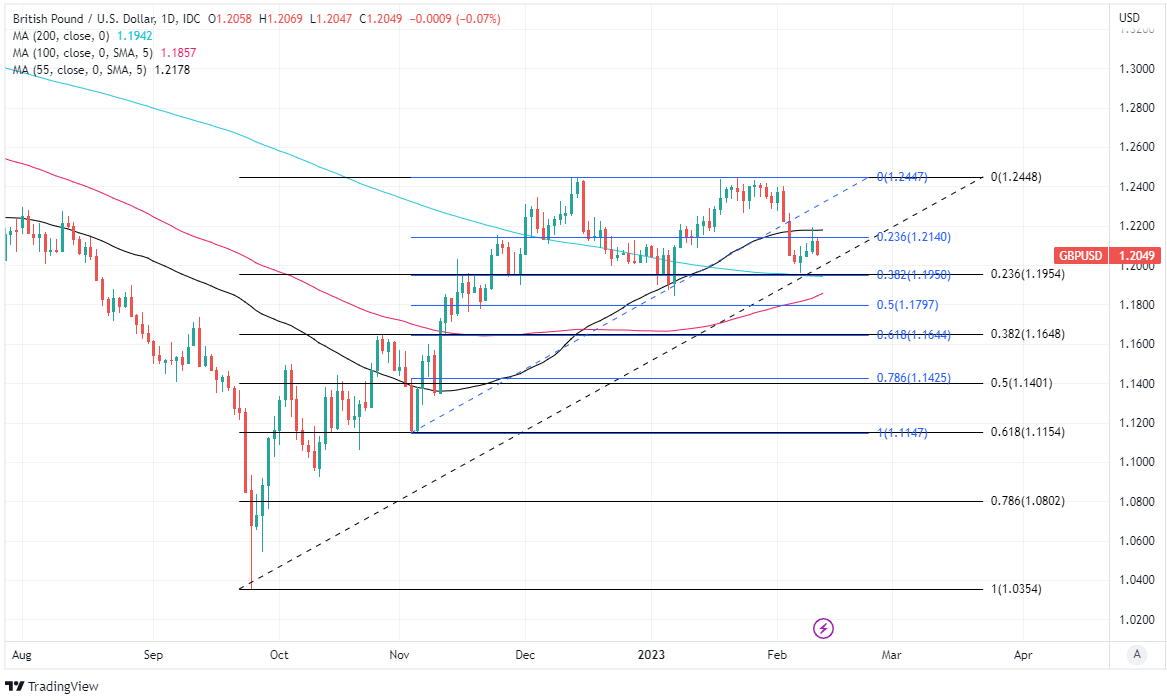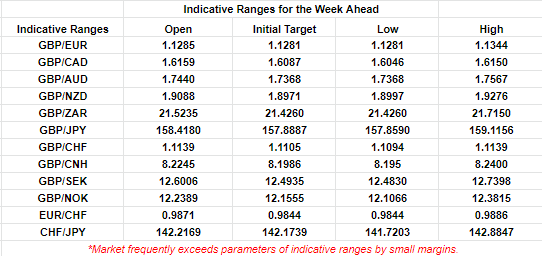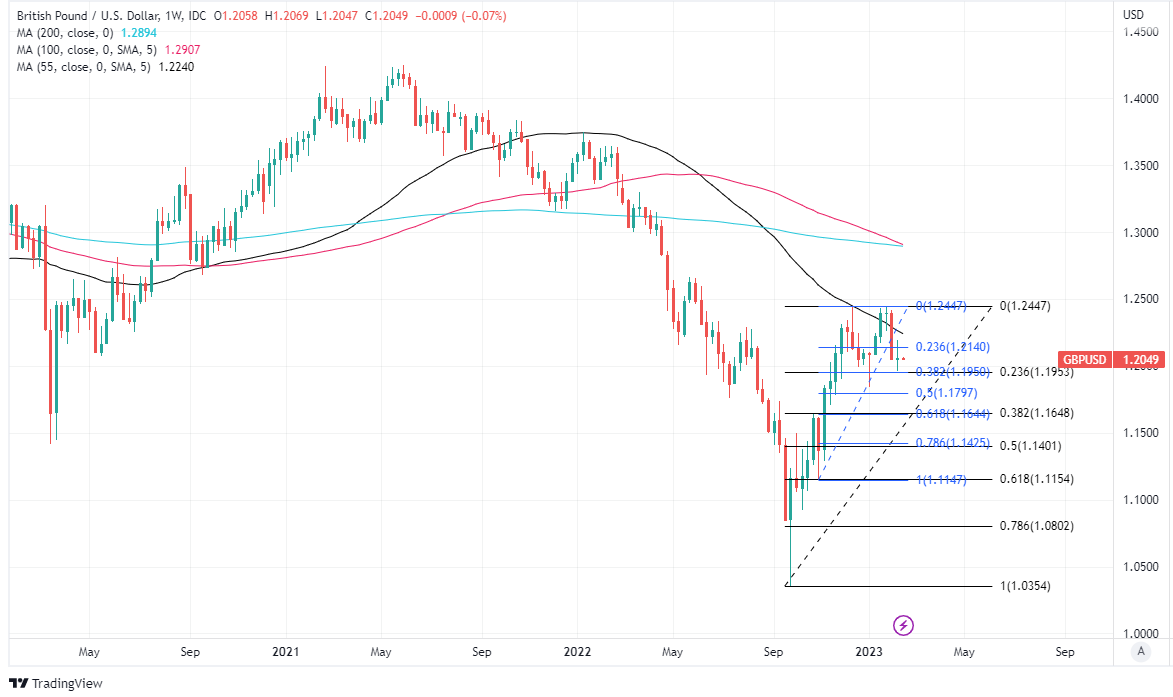GBP/USD Week Ahead Forecast: Supported Near 1.1950 but Upside Limited
- Written by: James Skinner
- GBP/USD underpinned by multiple layers of support
- Fibonacci levels & key average underpin near 1.1950
- Resilient USD limits scope for rebound as CPI looms
- U.S. CPI, retail sales, PPI & Fed policy chatter all key
- UK employment, wages & inflation data also in focus

Image © Adobe Images
The Pound to Dollar exchange rate has stabilised following its early February sell-off and could remain supported above the nearby 1.1950 level in the days ahead but its scope for recovery would be limited unless this week's U.S. data questions the idea of a disinflation process being underway.
Sterling edged higher against a resilient Dollar last week in price action that was seemingly aided by an increase in UK government bond yields and supportive remarks from members of the Bank of England (BoE) Monetary Policy Committee (MPC).
Members forming a majority on the nine-seat MPC suggested last week that further increases in Bank Rate would be likely if UK wage growth or other factors threaten to keep inflation stronger for longer, and Tuesday's job data is likely to provide insight along these lines.
However, U.S. inflation numbers for January are out soon after and would potentially undermine any attempted recovery in the Pound-Dollar rate if it calls into question the notion of a corner having been turned in favour of a disinflation process now thought to be underway.
"GBP/USD can lift this week if the USD eases as we expect. GBP/USD can also receive support if UK average weekly earnings growth (Tuesday) or the core CPI (Wednesday) shows no signs of cooling," says Joseph Capurso, head of international economics at Commonwealth Bank of Australia.
Above: Pound to Dollar rate shown at daily intervals with selected moving-averages and Fibonacci retracements of various microtrends indicating possible areas of technical support. Click image for closer inspection.
GBP to USD Transfer Savings Calculator
How much are you sending from pounds to dollars?
Your potential USD savings on this GBP transfer:
$318
By using specialist providers vs high street banks
"The main risk to the USD this week is the US CPI for January (Wednesday Australian time). Underlying CPI measures have tentatively trended down in the past few months. But there are limits to how far they will trend lower while US employment costs are growing strongly. Therefore, the core CPI may surprise to the upside and lift US interest rates and the USD," Capurso and colleagues writes in a Monday research briefing.
U.S. inflation has eased in recent months, leading Federal Reserve (Fed) Chairman Jerome Powell and other Federal Open Market Committee members to acknowledge with cautious optimism that a disinflation process may now be underway.
It would take time for such a process to lead inflation back to the 2% target, however, and there is a risk of setbacks along the way that could lift expectations for interest rates and lead to a less supportive environment for non-Dollar currencies including the likes of Sterling.
"In short, this week’s inflation data have the potential to interrupt the more relaxed inflation outlook that has gripped markets in recent months," says Michael Cahill, a G10 FX strategist at Goldman Sachs.
"Our latest work suggests that market responses to data surprises are becoming somewhat more symmetric. However, if the January inflation data fail to “rise to the occasion,” then the macro backdrop could continue to push towards Dollar depreciation," Cahill and colleagues write in a Friday research briefing
Above: Financial model-derived estimates of probable trading ranges for selected currency pairs this week. Source Pound Sterling Live.
(If you are looking to protect or boost your international payment budget you could consider securing today's rate for use in the future, or set an order for your ideal rate when it is achieved, more information can be found here.)
The most important detail in this week's report will be the pace of inflation in the non-housing parts of the services sector as these have been flagged by the Fed as being a prominent influence on its thinking about interest rates.
Tuesday's U.S. data is followed on Wednesday by inflation figures from the UK and by retail sales figures for the month of January from the U.S., all of which will play a role in determining if the Pound to Dollar rate is able to get past technical resistance that barred its path above 1.22 last week.
The risk is for Sterling that a stronger-than-expected rebound in U.S. inflation conspires with resilient retail sales to lift expectations for the Federal Funds rate while scuppering any further attempted recovery by the Pound-Dollar rate.
"The rise in the 2yr year is a technical break out from the downtrend from the November highs and underpins my view that we are in the midst of a USD correction higher that will see DXY carried up to 107/108 area over the course of the weeks ahead," says Brad Bechtel, global head of FX at Jefferies.
"GBP/USD is sandwiched between the 50dma and 200dma and I still see no reason for GBP/USD to be up here. 1.1500 maybe but 1.2100 just doesn't make sense to me," Bechtel writes in a Friday market commentary.
Above: Pound to Dollar rate shown at weekly intervals with Fibonacci retracements of September recovery indicating possible arease of technical support for Sterling. Selected moving averages denote possible resistance. Click image for closer inspection. To optimise the timing of international payments you could consider setting a free FX rate alert here.







